Israel’s 40-mile-long chain of walls and fences at its Gaza border teems with sensors and automated weapons. It is supported by an electronic intelligence network that monitors every phone call, text message and email in the territory. A large, well-trained military stands ready with state-of-the-art weaponry to respond rapidly to threats.
These defenses were built upon much the same technology that the U.S. military uses to keep its citizens safe and watch over its interests around the world and NATO armies use to monitor the border with Russia and the Middle East. So when thousands of Hamas militants slipped through Israel’s defenses on October 7, killing 1,200 Israelis and taking about 240 hostages, what presumed to be a vast technological advantage suddenly seemed deeply flawed.
The attack left Israelis, both citizens and military experts, deeply shocked at the country’s vulnerability. It has also reverberated through the halls of the Pentagon and the military establishments in many countries. Military experts are worrying about what some see as an overreliance on high-tech security to keep installations and homelands safe from attack. If Israeli security can’t protect against a relatively low-tech terrorist organization like Hamas, what havoc could Russia, China or some other advanced adversary deliver?
“The lessons for the Pentagon are huge,” says Amy Nelson, a foreign policy fellow at the Brookings Institution. “The countries with the highest tech defenses and the most modern militaries won’t necessarily win the battle. Surprise attacks can still get through.”
For the United States, the biggest lesson may be that relying on sophisticated technology is not always a good substitute for what people can do, even if it avoids putting them in harm’s way. For this reason, military and security officials are studying Israel’s disastrous showing in three essential areas: repelling intruders, deterring missiles and eavesdropping on its enemies.
“The Israeli military is the most powerful and technologically capable power in the Middle East, hands down,” says Bradley Bowman, senior director of the Center on Military and Political Power at the Foundation for Defense of Democracies, and a former U.S. Army pilot who later worked in the U.S. Senate as an expert on anti-terrorism technology. “Now they’re trying to understand how a barbaric adversary was able kill more Jews in a single day than at any time since the Holocaust.”
The Smart Border
Israel’s sprawling array of state-of-the-art defenses at the Gaza border were supposed to have left the country nearly invulnerable to anything Hamas was capable of throwing at them.
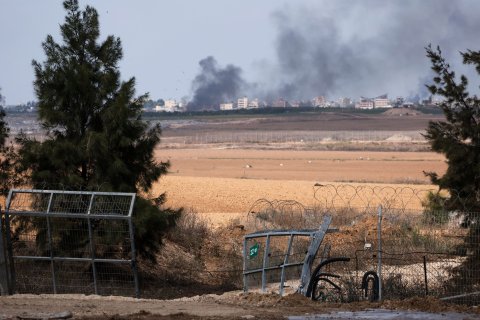
Instead, the October 7 attack was the deadliest day in Israel’s history. Over 2,500 Hamas militants freely streamed over, through and under Israel’s border walls and fences, encountering little resistance. For hours, the attackers rampaged through Israeli villages, a handful of military outposts and a music festival, slaughtering about 1,200 people, mostly civilians. Most of the attackers escaped back into Gaza, dragging with them about 240 mostly civilian hostages.
“Israel has what was supposed to be one of the premier intelligence systems in the world,” says Iain Boyd, Director of the Center for National Security Initiatives at the University of Colorado. “But they seem to have been hit completely cold.”
Israel had sunk more than a billion dollars into its high-tech border barrier along Gaza, which was completed in 2021. The so-called Iron Wall consists of walls and fencing that not only rise as much as 20 feet above the ground, but also sink deeply into it, to make it harder to tunnel beneath. The boundary boasts a staggering array of sophisticated equipment, including hundreds of night-vision cameras, seismic sensors to pick up tunneling sounds from deep below, thermal sensors to detect body or vehicle heat and radar to spot flying threats. Mobile robots sometimes patrol the perimeter. Small blimps and drones often look down from above. And automated machine guns on top of the walls can be fired from remote installations or triggered by sensor alerts to fire on their own, with AI doing the aiming.
The idea that thousands of assailants would be able to use explosives and heavy equipment to violently burst through these defenses without triggering a massive alert would have seemed absurd only a few weeks ago. This system was supposed to immediately alert the military to small incursions, preventing even a single assailant from quietly breaching the wall, let alone hundreds of militants intent on mass carnage.
In theory, virtually every sensor on or near the wall should have blasted out alerts to nearby Israeli military outposts, sending soldiers rushing to control panels to call up live video feeds from cameras, thermal imagers, drones and autonomous patrol vehicles. In addition to sending whatever troops, tanks, aircraft and other fighting vehicles and weaponry were on hand, the outposts would have sent out broader alerts for reinforcements, which could have brought in a massive response. Soldiers in the outposts, meanwhile, would have taken control of the wall-mounted machine guns, firing everything from bullets to grenades to small missiles at the incoming militants—though by that time the guns should have been firing on them autonomously.

Experts stress that many details of how the attackers foiled Israel’s defenses are still unknown; so far Israel has revealed little publicly. Still, a number of key points about the attack have emerged, shedding some light on the shocking failures of Israeli’s defense. But with the benefit of several week’s hindsight, what follows is a best guess as to what may have happened, according to experts interviewed by Newsweek.
In the early hours of October 7, Hamas militants used bulldozers and bombs to breach the barriers in about 30 places, many driving through the gaping holes on motorcycles and in cars. Some sailed over the barrier in paragliders.
The first wave of attackers started with a few simple tactics to defeat the smart defenses and keep the alarms from sounding and the guns from firing. First, they fired on the easily identifiable cameras and other sensors and automated machine guns, disabling them. They blew up the three prominent command and communications towers built into the wall with explosives launched on small projectiles or dropped from drones. If any alerts were triggered, they apparently didn’t make it to a major military command center.
Nor, apparently, were local military outposts warned; many soldiers at the outposts were killed in their beds, presumably oblivious to the attack. Warning calls probably never reached them or other Israeli outposts and command centers because Hamas was jamming cellphone communications coming out of the border area. The militants may well have used commercial handheld jammers, available online for as little as $800. These devices use a simple technique to disrupt signals: Blasting out electronic noise on the frequencies used by cellphone carriers. “It’s one of the first rules of warfare,” says Brookings’ Nelson. “Take out the enemy’s communications.”
Once the militants passed through the barriers, there would be little need to worry about triggering other sensors or automated weapons—all the defenses were aimed at the Gaza side of the border.
Overcoming Missile Defenses
It wasn’t just Hamas fighters coming unimpeded across the border. A barrage of as many as 5,000 missiles fired from Gaza came, too, overwhelming Israel’s “Iron Dome”—a missile defense system the country trusted to fend off serious damage from Hamas’ arsenal. Dozens of rockets broke through and struck Israeli cities and villages, killing at least five people.
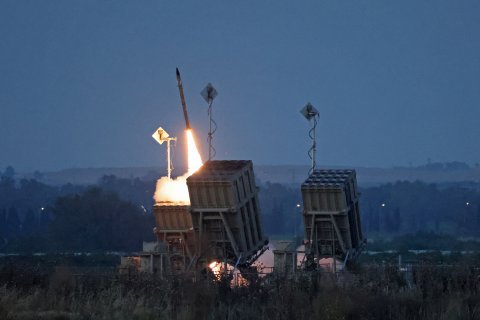
The Iron Dome missile defense system is designed to pick up any incoming missile on radar, use AI to determine by its trajectory if it constitutes a threat to a populated area and, if so, launch an interceptor missile to blow it out of the sky. The $1.5 billion system has worked well for Israel since it was completed in 2011, taking out about 95 percent of incoming rockets.
Hamas used a simple tactic to beat the Iron Dome: it simply overwhelmed the missle defense system with sheer numbers. Hamas fired between 3,000 and 5,000 rockets on the day of attack. Israel had only about 1,000 interceptors in the field, and couldn’t reload fast enough to keep up with the barrage. It may seem surprising that Hamas had far more rockets than Israel had missiles, but rockets are cheap, so the economics worked in Hamas’ favor. “Israel’s interceptors cost more than $50,000 apiece,” says the University of Colorado’s Boyd. “That’s 100 times more than the cost of a Hamas rocket. It allowed Hamas to overwhelm the system.”
The third bulwark to fail during the Hamas attack was Israel’s signals surveillance—that is, the ability to listen in on every phone call made in Gaza, and monitor all forms of electronic communications. Israel counted on that eavesdropping to provide an early warning of a potential attack, on the assumption there would be telltale chatter between militants. Hamas apparently turned that capability against the Israelis by not only relying strictly on face-to-face communications to plan the attack, but by purposely making comments in phone calls suggesting little appetite for confrontation.
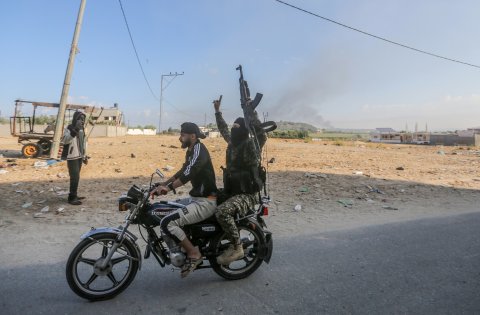
With its nearby bases overrun by Hamas, its electronic eyes blinded, and its local communications cut off, the Israeli military offered little by way of counterattack. It wasn’t aware of the invasion for nearly two hours, and six hours passed before an alert was issued that a major crisis was taking place.
At some point in the early hours of the attack, a single Israeli Merkava tank showed up to confront a group of Hamas militants. It should have been a lopsided battle; the Merkava is one of the world’s most advanced tanks, bristling with powerful guns, sophisticated targeting electronics and the latest in defensive armor.
But the militants quickly blew up the tank, enlisting the same trick that Ukrainian forces have used against Russian tanks: Grenades dropped down from small, commercially available drones. The second Merkava to take on the attackers quickly met the same fate. (Within days, the Israelis would take a page from the Russians’ book and tack on improvised slat roofs sitting on poles above the Merkava’s turret, in the hope that grenades would bounce off them.)
Essentially, every component of Israel’s celebrated high-tech defense capabilities failed, amounting to a total system collapse. But more than anything, it is the hours-long delay in responding that raises questions about the effectiveness of the country’s defenses. It took about eight hours for the first
significant Israeli military forces to arrive and begin to drive the militants back, and as many as 20 hours for the army to confront the last of the attackers.
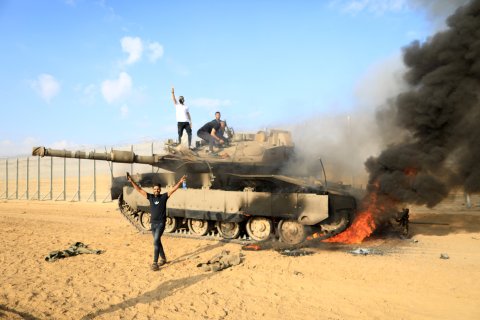
“Success in future battlefield engagement is going to be a function of who can close the ‘kill chain’ the quickest,” says Bowman. “That means being fast at detecting what your adversary is doing, deciding how to respond and delivering that response. Life and death will be a matter of seconds and minutes.” By that critical measure, he adds, Israel’s high-tech defenses performed dismally. In fact, the number of minutes it took the military to fully quell the attack—about 1200—roughly equals the number of Israeli civilians slaughtered.
Vulnerability Abroad
The increasing reliance on technology has long seemed like a winning strategy for the U.S. In the Gulf Wars in 1991–1992 and 2003, high-tech air defense systems and stealth bombers contributed to the “overwhelming force” that became a catchword of the U.S. military effort. In the past 20 years, the U.S. military has continued to increase its use of high-tech gear. Among the technologies that have reached advanced testing are autonomous missiles able to find their targets without having to be aimed at them, self-driving armored vehicles, energy beams that can disable enemy weapons and “exoskeletons” that surround a warfighter with power-tool-like metallic struts to amplify their strength.
Now, however, that technological advantage is beginning to succumb to the law of diminishing returns. Two decades of combat in Afghanistan proved that the most advanced weaponry and spy gear can be stymied by a low-tech adversary willing to hide among civilians, live in mountain caves, avoid electronic communications and sacrifice their lives to get at the enemy. And while it has been decades since the U.S. has been at war with an advanced nation, its major rivals today can largely match the U.S. military weapon for weapon—and, critically, exceed the U.S. military in sheer number of troops. “Technology is a force multiplier, but it’s not the Holy Grail,” says Boyd. “The Pentagon is watching what’s happening in Israel, and it has to be making them think about our own vulnerabilities.”
They need to think fast, says Bowman. “What happened in Israel is a version of what we might be encountering at any time,” he explains. “With Russia in Ukraine, China threatening Taiwan, Iran edging toward nuclear capability as it threatens Israel and the North Korea threat, we’re in the most daunting security environment I’ve seen in my lifetime.”
One reason the U.S. and its allies are concerned is that the U.S. relies on similar—and in many cases, the same—high-tech security as Israel. The Iron Wall defense system at the Gaza border, the Iron Dome missile defense and other Israeli defense technologies were jointly developed with the U.S. under agreements going back to the Obama administration. The Iron Wall became a particular favorite of the Trump administration, which planned to build its own version along the Mexico border.
Today many of those technologies, or systems similar to them, are deployed on U.S. borders. Israel, in fact, provided many of the drones that the U.S. depends on to spot illegal border crossings and other threats at the southern border—the same drones Israel uses at its own borders. The Department of Homeland Security’s Science and Technology Division has publicly talked up its efforts to deploy new imaging and radar sensors in “autonomous surveillance towers” at the border, drones to patrol the border and tunnel-detection sensors similar to Israel’s. U.S. Customs and Border Protection (CBP) is even testing autonomous robot dogs. All told, nearly a billion dollars has been earmarked specifically for high-tech upgrades to Customs and Border Protection’s technology arsenal since 2017.
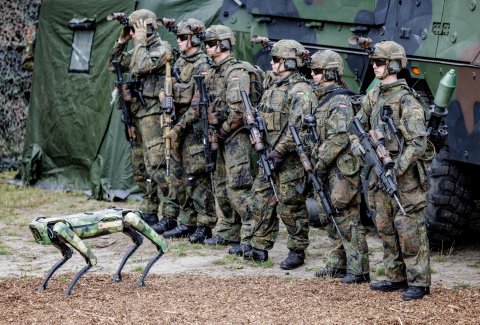
Security at the U.S. border doesn’t currently include remote-control or autonomous machine guns. But the U.S. military uses them to protect military bases and Navy ships. Specifically, the U.S. has fielded about 100 of Israel’s Samson Remote Controlled Weapon Stations, the same ones deployed at Israel’s Gaza border. The U.S. Army has also purchased the Israeli-made Skylark ultra-portable surveillance drone.
That’s just a few of the many high-tech defense systems developed by, or jointly with, Israel, and which are deployed by the U.S. military to protect cities and military bases around the world. The Iron Dome interceptor missiles are largely made in America; the U.S. Marine Corps has 2,000 of them on order. The Iron Dome launch platform is Israeli-made. The U.S. has two of them—both of which are soon to be shipped to Israel to bolster its post-October-7 defenses. The U.S. Army and Israel both also field the more powerful “David’s Sling” high-tech anti-missile system, developed jointly by the two countries.
Like Israel’s Merkava tanks, the U.S. M1 Abrams tank and other armored vehicles are protected by several high-tech systems, some of them shared with Israel. These include the Trophy system, which detects incoming missiles or other projectiles and automatically fires its own small missile to blow them up, and the Iron Fist system, which electronically confuses the GPS signals of incoming missiles and can trigger a blast whose shockwave can further knock them off course. Israel also provides the U.S. with “reactive armor tiles” that are mounted on the outside of tanks, exploding outwards when struck by a projectile to protect the tank’s interior.
On top of these technologies, more than a billion dollars a year from the Pentagon’s budget is going to AI. Some of that spending will produce more military vehicles and weapons that have the capability to work autonomously—which means less involvement by human soldiers. Autonomous sub-hunting ships and tank-seeking missiles are already far along in testing.
If a group as poorly resourced as Hamas was able to blow past Israel’s highly regarded technological defenses, imagine what these vastly more advanced potential adversaries might be able to do to challenge the U.S. defense-tech edge. “These countries and their terror proxies are gaining more and more capabilities, and accessing incredibly impressive technological capabilities,” says Bowman.
China and Russia have become expert in cyberwarfare and AI. They field their own stealth bombers and “hypersonic” missiles that move too fast for existing missile-defense systems to target. Iran is one of the world-leading fielders of bomb-equipped drones and North Korea can launch as many as 60 nuclear missiles on rockets that can travel with fair accuracy up to 10,000 miles.
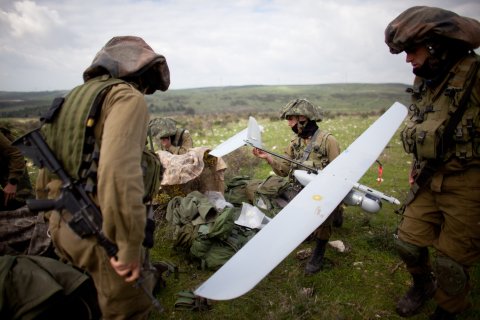
Lessons Learned
Israel itself, of course, will be first in line to reassess its reliance on high-tech security and learn what lessons can be gleaned from the October 7 horror. And that terrible experience offers one lesson above all others, asserts Yossi Kuperwasser, director of research at IDSF, an Israeli defense think tank with close ties to the military. That lesson: Don’t be overly reliant on technology alone. “When you start to feel that you can control the situation from afar and don’t need to be right there on the ground, you are making a big mistake,” he says.
Kuperwasser can speak from experience. He is a general in the Israeli army reserve and a former head of research for the Israeli army’s Intelligence Corps, served in Israel’s last two wars and was an intelligence attache to the U.S. That perspective has made him adamant about the limits of technology. “No technology can replace the soldier on the battlefield,” he says.
What’s seductive about technology, Kuperwasser explains, is that it’s less costly than troops on the ground—both in financial terms, and because of a country’s understandable aversion to casualties. Technology can work tirelessly without food, water or pay; catch what human eyes might miss; and strike faster, more accurately and over greater distances than humans can. No one weeps when a machine is taken out.
Still, Kuperwasser maintains that it’s the combination of the technology and people that will protect civilians and win battles. “AI and state-of-the-art technology can assist humans, in ways that are constantly improving,” he says. “But you can’t avoid the need to keep people in the loop. If you depend too much on the technology, you get surprised, the way we were. Every time you put a technology solution in place to deter an enemy, the enemy comes up with a new way to overcome it.”
Adversaries are becoming good at disabling sophisticated, costly technologies with simple, crude techniques. “Hamas did what it did with comparatively low-tech tools,” says Nelson. “They used commercially available technologies to go up against sensors and tanks that cost millions.” And making technology vulnerabilities much worse, she adds, is that they tend to come to light only when the enemy suddenly exploits them, as happened in Israel. “High-tech weapons and defenses are brittle, and often untested in combat conditions.” The result, she says, are ugly surprises when they can least be afforded.
Troops remain the ultimate weapon, says Boyd, and to a large extent success in warfare and defense all comes down to how many are deployed. It was the sheer number of militants swarming into Israel that ultimately proved to be so deadly. It’s sobering to consider that North Korea’s military troop count is about three times as large as the U.S. “If North Korea invades South Korea, even with the U.S.’ help they are likely to overwhelm defenses with the sheer number of people they deploy,” he says.
When it comes to deploying troops, both the U.S. and Israel, along with many of their allies, share a sort of disadvantage: They are less willing to accept casualties than many of their adversaries. Little mentioned in the river of shocking news that came out of Israel at the time of the attacks is that ultimately more Hamas militants were killed in the October 7 attack—about 1500—than Israelis. But Hamas celebrated, while Israel mourned. “When you’re more prepared to sustain casualties, as many adversaries are, you’re going to be more reliant on technology,” says Boyd. “That’s more politically acceptable in the U.S. today.”
The horrors that fell out of Israel’s overreliance on high-tech defenses will provide crucial lessons to Israel and others, says Kupperwasser. “The only problem,” he says, “is that we pay such a heavy price for them.”

 Unmanned Aerial Vehicle The latest drone news
Unmanned Aerial Vehicle The latest drone news




